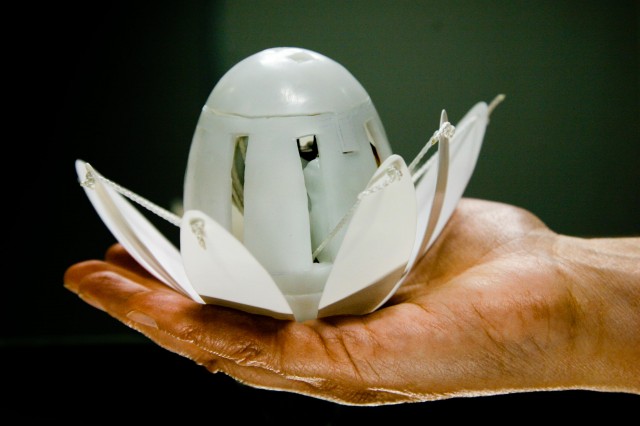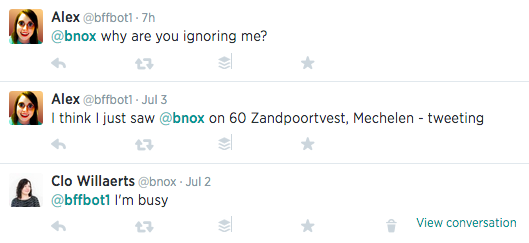Digital Utopias — Reviewed
Hoping to discover how new technologies are enabling creativity across the arts, Laura Robertson realises that commissioning successful, high quality and ambitious projects will always rely on good people…
“When you share data, the rewards are far greater than keeping it to yourself.” So said the ever-upbeat Arts Council England Chair Peter Bazalgette on Tuesday as he opened the Digital Utopias conference. Populated by an expectant crowd of arts directors, producers, artists, curators, scientists and technologists, all were keen to hear ‘how new technologies are enabling creativity across the arts’. It was a showcase of industry leading lights, examples of good practice and collaboration, and an exercise in de-mystification; a chance for those who don’t currently engage with digital specialists to think about how they might do so in the future.
As alluded to in the opening statement, and various speeches given by Bazalgette over the last 12 months, the Arts Council appear especially keen on encouraging producers to share data more freely (something arts spaces can be reticent about), using technology to both distribute content and engage with new audiences.
We chose to start our morning session with the audaciously titled After the Future debate; promising to examine how art is changing in the digital age, and how new behaviours and systems are emerging in the creation, exhibition, interpretation and dissemination of art.
Chair, curator and researcher Sarah Cook shared examples of artists working in an admittedly ‘growing and chaotic field’: creating new life forms in vials and test tubes, as Sneha Solanki did in Super-Natural (2012), or mapping the future terrain of Mars with the help of NASA, like Kelly Richardson’s Mariner 9 (2013). Artist Jon Thomson (Thomson and Craighead) gave us a 20 minute presentation of his own works, including the irreverent “desktop documentary” series Belief (2009/10), and was followed by Frieze writer Morgan Quaintance, who gave an excellent, whirlwind tour through a Post-Internet art movement that has grown in popularity yet become ever more insular. Former Cultural Olympiad lead Ruth Mackenzie, now director of controversial new £16m online gallery The Space, spoke about its importance as a developer of new talent, and the way in which their artists (including Ed Atkins and Ai Weiwei) are “challenging the idea of participatory art.”
All speakers assured us that artists are the ones re-framing digital culture, pushing technology to change and evolve. Time emerged as a key issue; by the end of The Space’s latest 10-year commission with Atkins, the digital tools he will engage with will surely be defunct. Digital, for artists and audiences alike, tends to encapsulate a sense of fleeting time, especially surrounded as we are with the next open browser, updated software or new cat video. Yet as Quaintance put it, ”contemporary art is really good at slowing things down.”

A flaw in the day was that each question, either posed in the programme, or asked by the eager audience, required a debate on their own: ‘What are the practical challenges and values which should inform the future?’; ‘How can our media art history inform the sector?’ The panelists could not hope to give thorough answers in the allotted time; leading to a confused flurry of viewpoints and even more questions. The speakers in this session had no more than 10 minutes to squeeze in analysis. This kind of industry showcase event would benefit from expanding into a festival, awash with more specific workshops, one-to-one advice surgeries and debates with strict and clear outcomes. This is a compliment, really — the demand is obviously far greater than the supply.
Next up: Designing Performance. Maria Oshodi told us about her pioneering theatre company Extant, which creates a “levelling experience” for visually impaired and non-visually impaired performers and audiences alike. Working with the Open University, Battersea Arts Centre and robotics specialists, the Haptic Lotus was devised: a hand-held object that would change its form in response to the holder’s journey through a pitch dark installation. Equally ground-breaking design studio Marshmallow Laser Feast, represented by producer Eleanor Whitley, advised: “Don’t use technology for technology’s sake”; referring to the complex development period of The Measures Taken, a collaboration with the Alexander Whitley Dance Company (performed to delegates’ delight later that evening). Currently working on Project Daedalus with Abandon Normal Devices and the University of Salford, they are researching drones as props, characters and production tools.
The Royal Shakespeare Company’s Sarah Ellis, to giggles from the audience, told us her favourite innovator was 16th century painter Holbein; reminding us that we have been in an age of innovation before, and we’re not alone. For those still worried about commissioning artwork using new technology, Ellis asked us to allow artists to be the guide, insisting that ”art does ask the right questions”, and that the whole point was to allow imagination and ideas to work hand-in-hand. A lesson to take away here was that, as always, nurturing good relationships with people who know what they’re doing is still the best way of producing a high quality result.
As a magazine, it would have been idiotic of us to miss Copy and Paste: a showcase of how technology is playing a pivotal role in literature. Joanna Ellis from The Writing Platform talked about creating a positive response to issues facing writers, including bursaries for writers and technologists to collaborate on new projects which may seem impossible or “crazy” to other funding bodies. It was uplifting to see previous bursary winners — interactive storytelling platform Fabler, and curious adventure map Invisible Islands – being supported in this way. Jim Hinks from non-profit publishers Comma Press revealed the ongoing development of MacGuffin, a “really searchable jukebox for fiction and poetry” that hoped to help readers find new stories they wanted to read, whilst giving all kinds of feedback to the authors (including where in the world their story was being read, what hashtags where being created and, crucially for a story in draft, if they read to the end and/or what page they abandoned it at).

Most entertaining speaker of the day, artist Eric Drass, set the tone by declaring: “Big data is bollocks.” Drass talked about “the blandification of modern politics”, morphing David Cameron and Ed Miliband into one (Algo-Politics (2012)); feeling guilty about not reading things that take too long to read (tl;dr;lit (2014)); and, my favourite, creating a Best Friend Forever bot so unsettling and creepy that even he had to stop working with it (@BFFbot1 (2014)). A maker of modern horror, Drass exploits digital tools to expose and unpick the culture it has spawned.
The last session of the day Activating the Public Space was, unfortunately, really boring; suffering from a lack of energy and long-winded, confused questions (again squashed into the last 10 minutes). The good news is it introduced us to New York’s YesYesNo – responsible for public projects encouraging us to drink more (Drink Up Fountain) and cross barriers (Connecting Light) — and Nottingham’s GameCity Festival — normalising technology for a wide range of audiences with the attitude, as director Iain Simons put it, of “the best village fete in the world.”
As it said on the tin, Digital Utopias was a good introduction to ‘how new technologies are enabling creativity across the arts’. Set in the Hull Truck Theatre, it also gave insight into the future City of Culture celebrations; opening and closing the day, Culture Company CEO Martin Green was keen to show a commitment to 2017′s contemporary arts offer, the town’s growth as a place of innovation (citing resident creative/digital/ tech businesses like Summit and SGS), in addition to highlighting the hurdles they have to jump in the two-year lead up (including high unemployment rates).
The conference was a fitting moment to ponder how cultural investment is seen as the answer to achieving ‘utopia’ (think of the impact of Capital of Culture has had on previous winners Liverpool and Glasgow). As digital light beams flickered and faded around a solitary dancer in The Measures Taken, signalling the end of the conference, all that was left to do was wonder.
Laura Robertson
Digital Utopias is curated by Abandon Normal Devices as a trailblazer event for Hull City of Culture 2017, bringing together a range of partners including The Space, Innovate UK, ODI and AHRC as well as artists and cultural practitioners from across the UK and beyond.
Digital Utopias is one of a series of three Arts Council events that are supported by Google.
See the full Digital Utopias programme here, and more of the conversation on Twitter through #artsdigital #digitalutopias
Featured image: The Measures Taken, by Marshmallow Laser Feast/Alexander Whitley Dance Company (2013). Centre images top to bottom: Haptic Lotus from The Question (2010), Extant; @BFFbot1, Eric Drass (2014)





